Library
All resources
2301 – 2320 of 2383 results
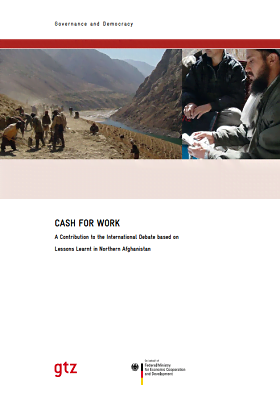
Cash For Work: A Contribution to the International Debate based on Lessons Learnt in Northern Afghanistan
Case Study
The purpose of this study was to document learning from BMZ finance cash for work (CFW) projects implemented by GTZ in Afghanistan as a contribution to international debates about cash transfer approaches. The operations of the GTZ CFW scheme in Northern Afghanistan are financed by the German Federal...
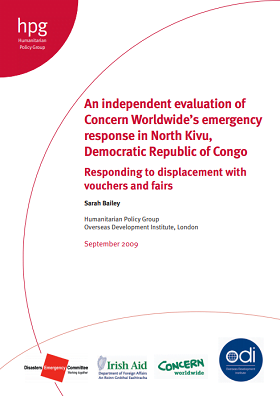
An independent evaluation of Concern Worldwide’s emergency response in North Kivu, Democratic Republic of Congo: Responding to displacement with vouchers and fairs
Case Study
In late 2008, escalated fighting among rebels and the Congolese Armed Forces (FARCD) provoked renewed and widespread displacement in North Kivu province, Democratic Republic of Congo (DRC). In response to the unfolding crisis, Concern Worldwide implemented the project Emergency Assistance to Newly...
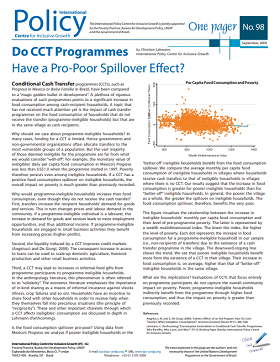
Do CCT programmes have a pro-poor spillover effect?
Report
This one pager looks at the indirect impact of cash transfer programmes on the food consumption of households which have not received a transfer, but are within the same village as households which have. The paper looks at why this occurs, using evidence from Mexico to show that this phenomena in indeed...

Lessons Learned from the Post Election Violence Early Recovery Programme in Kenya 2008-2009
Case Study
The Kenya Post Election Violence (PEV) Early Recovery Programme was an ECHO-supported response by six international NGOs to the ethnic and political violence which severely affected livelihoods in the Rift Valley, Nyanza and Central Provinces after the disputed national elections in late December 2007....

Fresh food vouchers for refugees in Kenya
Report
Read the report here This article in Field Exchange magazine outlines an intervention by ACF in Dadaab to improve the nutritional intake and dietary diversity of the refugee population of Dadaab, Kenya, through a complementary food voucher scheme targeted at malnourished children.
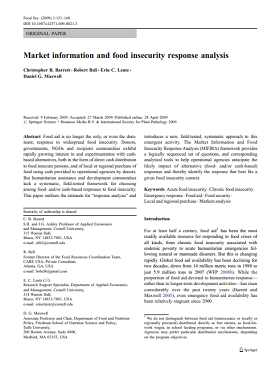
Market Information and Food Insecurity Response Analysis (MIFIRA)
Report
This paper outlines the importance and rationale for agencies to undertake a “response analysis” before choosing an appropriate programme delivery mechanism to a humanitarian situation. The Market Information and Food Insecurity Response Analysis (MIFIRA) framework is introduced. This provides a...

The Role of Cash Transfers in Post-Conflict Nepal
Report
Nepal is in the midst of a transformational process: the end of the eleven year conflict in 2006 has given way to the end of the monarchy, the development of a new Constitution, and a democratically elected government which emphasises an inclusive Nepali society. However, the peace process has been slow,...

The use of cash and vouchers in humanitarian crises: DG ECHO funding guidelines
Guidelines and Tools
A brief guide to assist programme staff in writing funding proposals for cash-based interventions. A humanitarian guidance note about cash transfer programming is also available.

Niger: Food Security and Safety Nets
Case Study
From the perspective of social protection, this study is designed to synthesize considerable existing analysis, review food and nutrition security policies and programs in Niger, and provide an action plan for strengthening the existing system and developing an effective food security and safety net...
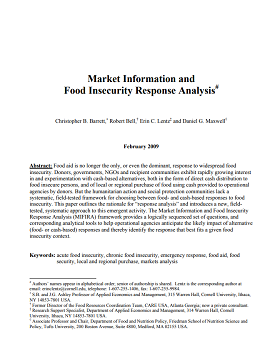
Market Information and Food Insecurity Response Analysis
Report
This paper outlines the importance and rationale for agencies to undertake a “response analysis” before choosing an appropriate programme delivery mechanism to a humanitarian situation. The Market Information and Food Insecurity Response Analysis (MIFIRA) framework is introduced. This provides a...

Money Matters: An evaluation of the use of cash grants in UNHCR’s voluntary repatriation and reintegration programme in Burundi
Report
To access another publication available in this series, titled ‘The Use of Cash Grants in UNHCR Voluntary Repatriation Operations: Report of a Lessons Learned Workshop’, please click here. There has been growing interest in recent years in the use of cash grants as a humanitarian assistance and...

Case Study: Indonesia – Sumatra 2009
Report
On 30th September 2009 a series of earthquakes struck West Sumatra, not far from the provincial capital of Padang. 13 out of the 19 districts in West Sumatra province were affected. Between earthquakes and landslides nearly 250,000 houses were destroyed or heavily damaged. This case study examines the...

How cash transfers can improve the nutrition of the poorest children: Evaluation of a pilot safety net project in southern Niger
Case Study
This report presents key findings from an evaluation of Save the Children’s pilot project to give cash transfers to 1,500 of the poorest households in Tessaoua district, Maradi region, Niger. Its findings will be of interest to NGOs, governments and donors involved in planning and...

A Guide to Economic Growth in Post-Conflict Countries
Guidelines and Tools
This Guide to Economic Growth in Post-Conflict Countries seeks to develop comprehensive recommendations for USAID and similar donors on how to encourage economic growth in countries emerging from conflict. The Guide is based on the premise that improved economic wellbeing can enhance the prospects for...
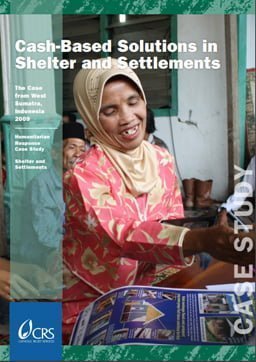
Cash-Based Solutions in Shelter and Settlements : Humanitarian Response Case Study, West Sumatra, Indonesia
Report
In many emergencies, shelter programs are implemented by the distribution of shelter or construction materials, so that CRS’ (Catholic Relief Service) program participants does not have to deal with procurement or the open market. Under certain circumstances (availability of local market, cultural...

Real-Time Evaluation Report for the CRS Pakistan Response in the Swat Valley
Report
CRS launched a response in September 2009 to support the return of at least 3,000 persons displaced from Swat Valley. CRS partnered with local organizations LASOONA and EPS to provide cash grants, vouchers for livelihood assets, and cash for work activities to restart livelihood activities for returnees...

Strategies for Development in Conflict Affected Countries in the ESCWA Region: The role of the state and private sector
Report
This study on private sector resilience in conflict-affected countries in the ESCWA region is part of a series of publications, which examines mechanisms and policies for development in spite of conflict. The studies include policy recommendations that are aimed at enhancing the capacity of policymakers...

From Food Crisis to Fair Trade: Livelihoods analysis, protection and support in emergencies
Report
This document aims to collate and analyse experiences of livelihoods programming in emergencies. It provides an overview of what livelihoods programming is and gives examples of the range of interventions that are possible in emergencies. Different types of livelihoods programmes are then described...
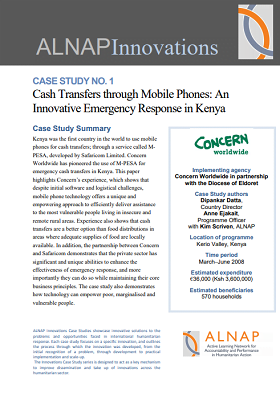
Cash Transfers through Mobile Phones: An Innovative Emergency Response in Kenya
Case Study
Kenya was the first country in the world to use mobile phones for cash transfers; through a service called M-PESA, developed by Safaricom Limited. Concern Worldwide has pioneered the use of M-PESA for
emergency cash transfers in Kenya. This paper highlights Concern’s experience, which shows that despite...
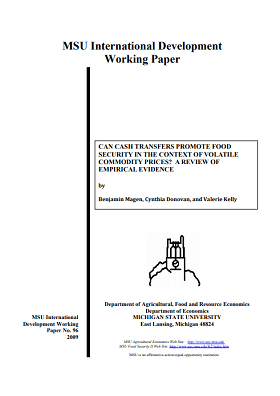
Can Cash Transfers Promote Food Security in the Context of Volatile Commodity Prices? A Review of Empirical Evidence
Report
This working paper synthesizes the theoretical and empirical literature on the use of cash transfers in response to food crisis situations, with particular attention to their use in situations that are exacerbated by volatile, often inflationary, commodity prices. The paper is designed for policymakers...